
Benefits of Open-Source Software for Developers, Managers and Business
When we think of open-source software, the first thing that comes to mind is the lack of fees and additional charges for using the system.
While this is undoubtedly extremely important, open-source software solutions and frameworks offer other, equally valuable benefits to developers, managers, and businesses alike.
This article explores the many benefits of open-source software and how it can help organizations save time and money, improve code quality and security, foster innovation and collaboration, and gain a competitive edge in the market. You don’t want to miss this!
Contents
- What is open-source software
- What is the difference between open-source software and proprietary software?
- Examples of open-source software
- Benefits of open source software for developers
- Benefits of open source software for business and managers
- Disadvantages of open-source software
- Choose open-source software development
What is open-source software
The term “open-source” was first introduced and adopted by the Open Source Initiative (OSI) nearly 25 years ago in 1998.
In the open-source paradigm, a community of developers works together, sharing expertise to collectively solve problems and combine efforts to improve and maintain a project for the collective benefit.
This collaborative approach is a cornerstone of the open-source ethos. It ensures unfettered access to the source code, which is free for anyone to examine, copy, and distribute to serve almost any purpose. This accessibility extends to the elimination of royalties and licensing fees.
It’s worth noting, however, that open-source software is not inherently cost-free. Some vendors, for example, reserve the prerogative to charge for software aggregation (distribution) and support services. On the other hand, some vendors offer their products under the open-source license (such as the gnu general public license), but some more advanced features are behind a paywall.
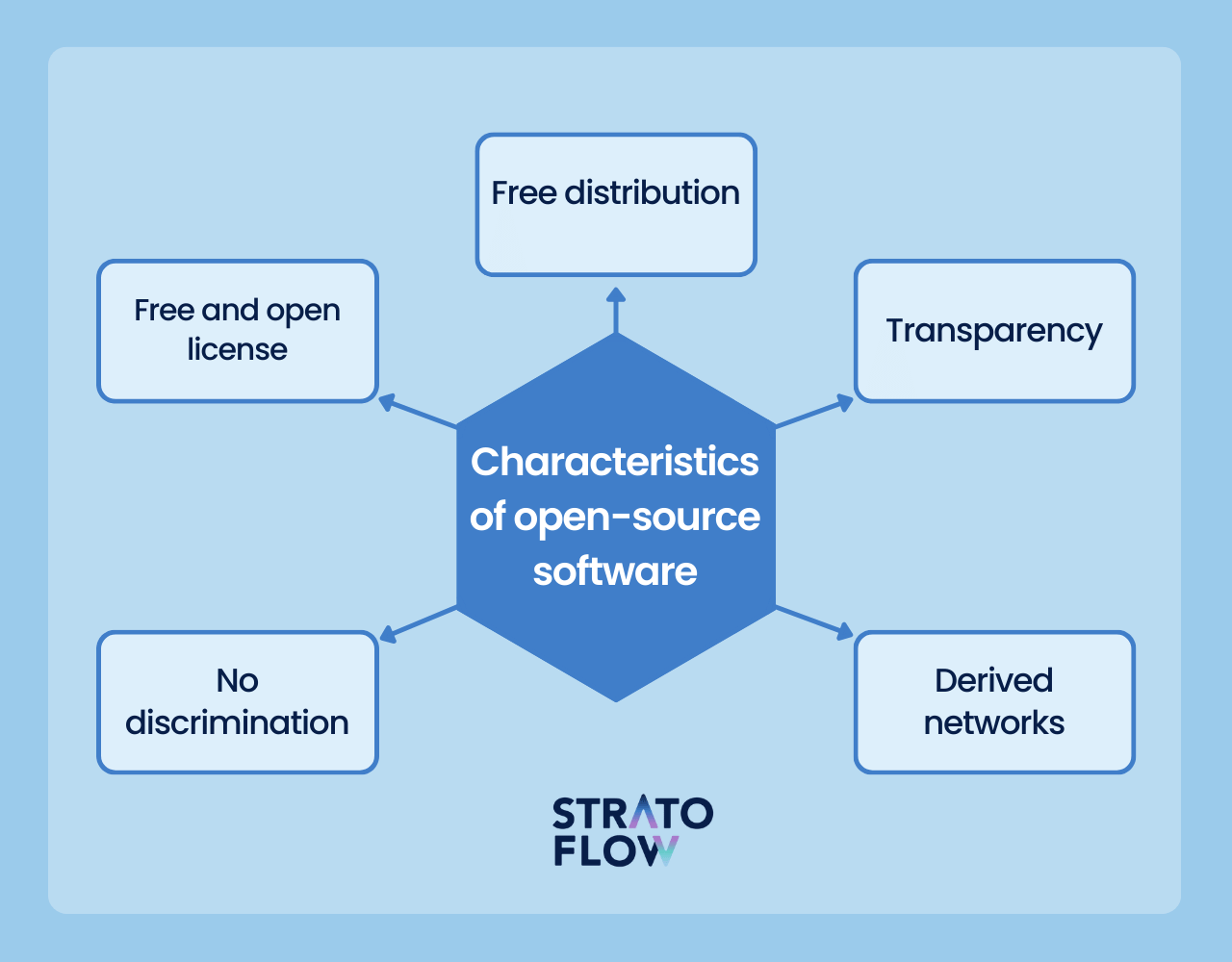
As we’ve mentioned before, according to the Open Source Initiative’s definition, free access to the source code is not the only requirement for software to be considered open-source. It must also meet the following criteria:
- Free distribution – Anyone can access, obtain, and distribute the software without facing restrictive barriers.
- Transparency – Users have the right to examine and modify the code underlying the software. This encourages community involvement, fosters innovation, and facilitates troubleshooting.
- Derived networks – Open-source software should enable users to create modified versions or derivatives of the software, encouraging customization to meet specific needs while still complying with the original software’s licensing terms.
- No discrimination – open-source software should ensure that there is no discrimination against individuals or groups in its usage. It must be accessible to all, regardless of factors such as field of endeavor, nationality, or economic status.
- License characteristics – software’s licensing terms should not impose constraints on other pieces of software that might be used alongside or in conjunction with the open-source software.
Importance of open-source software
It’s important to note that the importance of open-source technology is not limited to being a low-cost alternative for companies looking to start a new software development project, but can be superior to proprietary software in other ways as well.
Over the years, countless talented developers worldwide have worked on open-source projects, creating a rich tapestry of software tools, frameworks, and applications that power businesses, governments, and organizations. From the Linux operating system to the Apache web server, open-source software has become a cornerstone of the modern technology infrastructure.
Organizations often prefer to use these open-source software tools because the software selection and vetting process is much simpler and lengthy negotiations are unlikely. As a result, innovative applications can be rapidly deployed and adopted. Of course, in addition to improving speed to market, open-source software also prevents vendor lock-in and reduces costs, which remains one of its greatest benefits.
So how common are open-source solutions in the modern IT market? Widespread would be a gross understatement.
According to the latest data as many as 80% of IT departments plan to increase their use of open-source software over the next 12 months, with 95% of IT specialists agreeing that open-source has become strategically important.
In fact, open-source software solutions according to a survey are seen as “very important” drivers of digital transformation initiatives by 48% of companies.
What is the difference between open-source software and proprietary software?
Open-source software and proprietary software (also known as closed-source software) represent two distinct paradigms in the software industry that differ in their licensing, development, distribution, and ownership models.
Here are the five main areas of difference between the two:
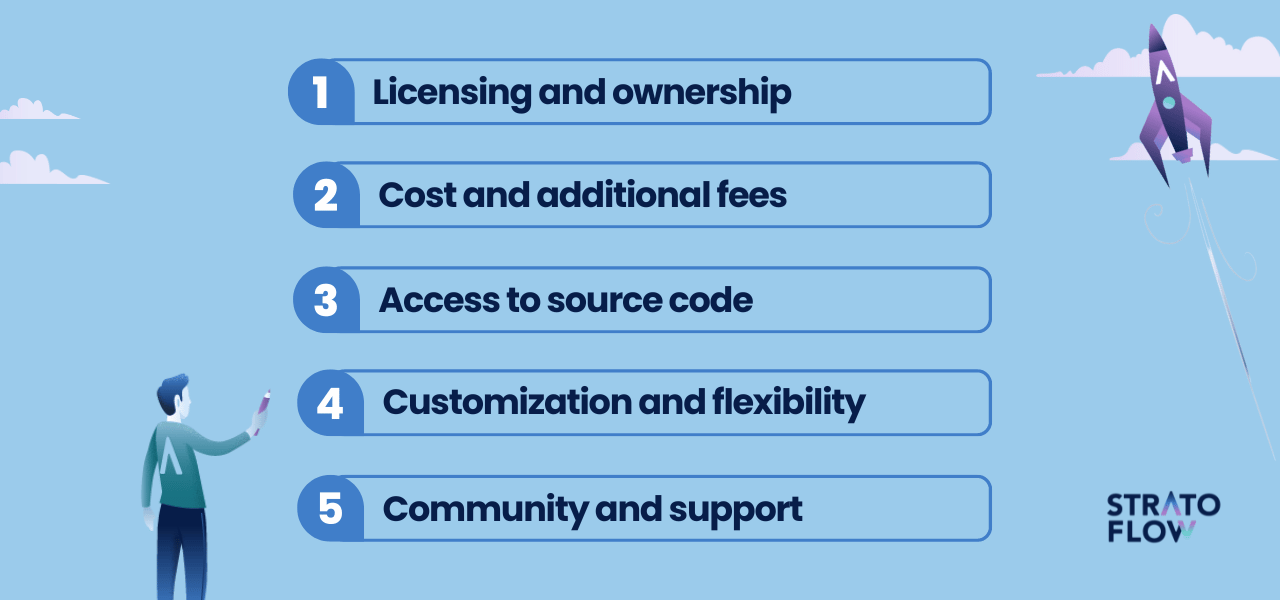
Licensing and ownership
- Open-Source Software – Open-source software is distributed with a license that gives users the freedom to view, modify, and redistribute the source code. Ownership of the software typically remains with the community or organization that initiated the project. Users have certain rights granted by the license, but do not own the software itself.
- Proprietary Software – Proprietary software is owned by a company or individual who retains control over the source code and its distribution. Users typically purchase licenses to use the software, but do not have access to or ownership of the underlying source code.
Cost
- Open-Source Software – Unlike proprietary software, open-source software is available for free. Users can download and use this free software without paying any licensing fees.
- Proprietary software – It is usually sold under different licensing models, including one-time purchase fees, subscription models, or per-user licenses.
Access to source code
- Open-Source Software – One of the defining characteristics of open-source software is that its source code is openly available. Users can view, modify, and contribute to the code, which promotes transparency and community collaboration.
- Proprietary software – The source code of proprietary software is typically closed, proprietary, and inaccessible to users. This lack of transparency can make it more difficult to identify security problems or customize the software.
Customization and flexibility
- Open-Source Software – Users can modify open-source software to meet their specific needs, making it highly customizable. This flexibility is especially valuable for organizations with unique requirements.
- Proprietary software – Customization options are limited to what the developer allows. Users may need to request custom features from the software vendor, which can be costly and time-consuming.
Community and support
- Open-Source Software – Many open-source projects have active communities of developers and users who provide support, share knowledge, and contribute to ongoing development. Support can vary, but is often available through forums, documentation, and third-party service providers.
- Proprietary software – Proprietary software typically comes with official customer support from the software vendor. The level and quality of support can vary depending on the vendor and the license agreement.
[Read also: How to Estimate the Cost of Software Development [Experts Insights]]
Examples of open-source software
Open-source components have been seamlessly integrated into numerous commercial applications, prompting industry giants such as Microsoft, Google, Amazon, Intel, IBM, Hewlett-Packard, Oracle, and SAP to actively participate in open-source projects.
As a result, open-source has permeated the software landscape and serves as the backbone for much of the Internet.
It plays a critical role in many areas, including server operating systems, web and mail servers, databases, programming languages, and content management systems (CMS), to name a few. Its influence extends far beyond that, into a variety of other application areas across the technology spectrum.
Here are a few examples of open-source software solutions that are key to countless software development projects worldwide:
- Operating systems – Linux
- Web servers – Nginx, Apache
- Databases – MySQL, MariaDB, Hadoop
- Programming languages – PHP, Python, Java, Ruby
- Cloud/virtualization – Docker, Kubernetes, KVM
- Encryption – GnuPG, OpenSSH, OpenVPN
Benefits of open source software for developers
While we may equate open-source with simple cost savings, these types of software solutions offer many benefits to developers as well. Let’s look at five of the most important ones:
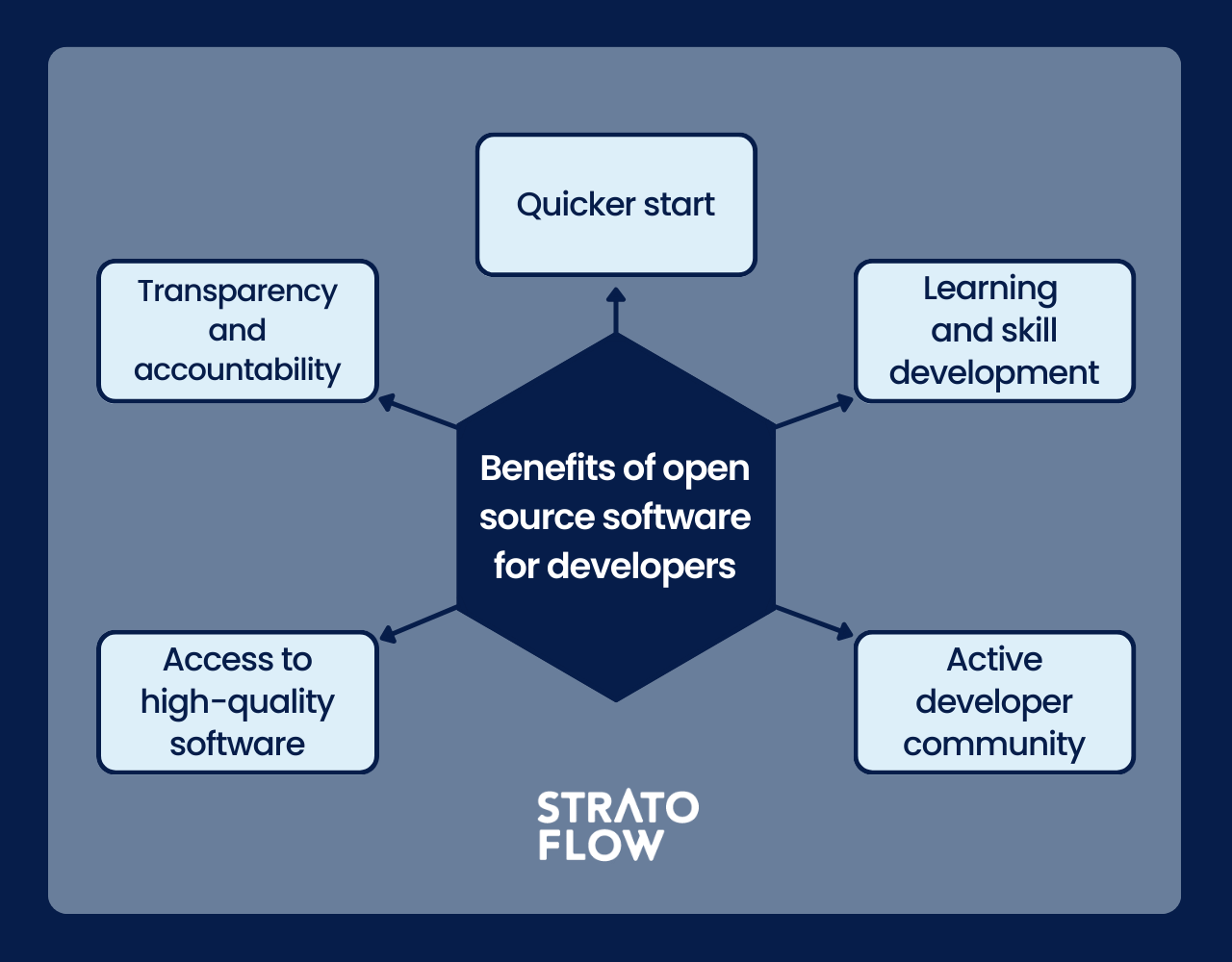
Quicker start
First and foremost, working with open-source software components allows developers to move more quickly to building business logic.
What does that mean?
Instead of sifting through a myriad of confusing options and navigating a new vendor’s onboarding process that may or may not address your organization’s needs and developers’ questions, open-source software solutions offer the potential for a faster project start.
Rather than figuring out which pricing tier to choose or waiting for professional support teams to respond, a team of software developers can access all the resources provided by an open-source project almost instantly – a great boost to all software development efforts.
Learning and skill development
In general, many software developers enjoy working on and with open source projects. It provides them with a valuable learning environment where developers can learn best coding practices and programming standards from well-established solutions that are free.
It’s important to remember that open-source is not limited to a few basic tools and programs. It encompasses a wide range of technologies, programming languages, frameworks, and tools.
This allows developers to explore different technologies and approaches that they may not have encountered in their day-to-day work, thereby broadening their skill set. What’s more, working with other experienced developers on an open-source project exposes programmers to different perspectives and approaches, facilitating skill development.

Active developer community
An active developer community is probably one of the most important aspects of open-source solutions from the point of view of software developers.
The open-source community in various software solutions provides invaluable support and resources to software developers, enhancing their work in numerous ways.
First, this community serves as a great knowledge hub where developers can access a wealth of forums and tutorials. In the case of well-established open-source projects, frameworks, and tools, programmers can tap into extensive documentation contributed by many users who have already worked with the software.
In addition, active communities ensure that the software remains current, secure, and well-maintained through ongoing peer review and contributions. This collaborative environment not only fosters individual growth but also empowers developers to deliver higher-quality software more efficiently.
Access to high-quality software
Open-source software code is viewed, commented on, and improved by a huge community of talented people.
What does this mean for the developers themselves?
The software they will be working on will be polished and free of almost all bugs and problems. Because it has been seen by so many pairs of eyes, its “teething problems” have long since been resolved and fixed. That’s one of the cornerstones of open-source software development – expressing and sharing the goal of creating excellent, high-quality software.
Transparency and accountability
What you see is what you get.
Transparency is one of the key benefits of open-source software solutions. Open standards allow users to examine the code, which tends to foster a higher level of trust in the software vendor. In addition, the public availability of the code gives users a sense of reliability, making it suitable for long-term projects because there is less concern about the software being discontinued abruptly.
Advantages of open source software for business and managers
Open-source solutions are currently at the forefront of digital transformation as in virtually every major software development project some, if not a majority, of frameworks and components are distributed according to open standards.
We see how open-source software can improve the job of software developers. Let’s now see the benefits it brings to the businesses.
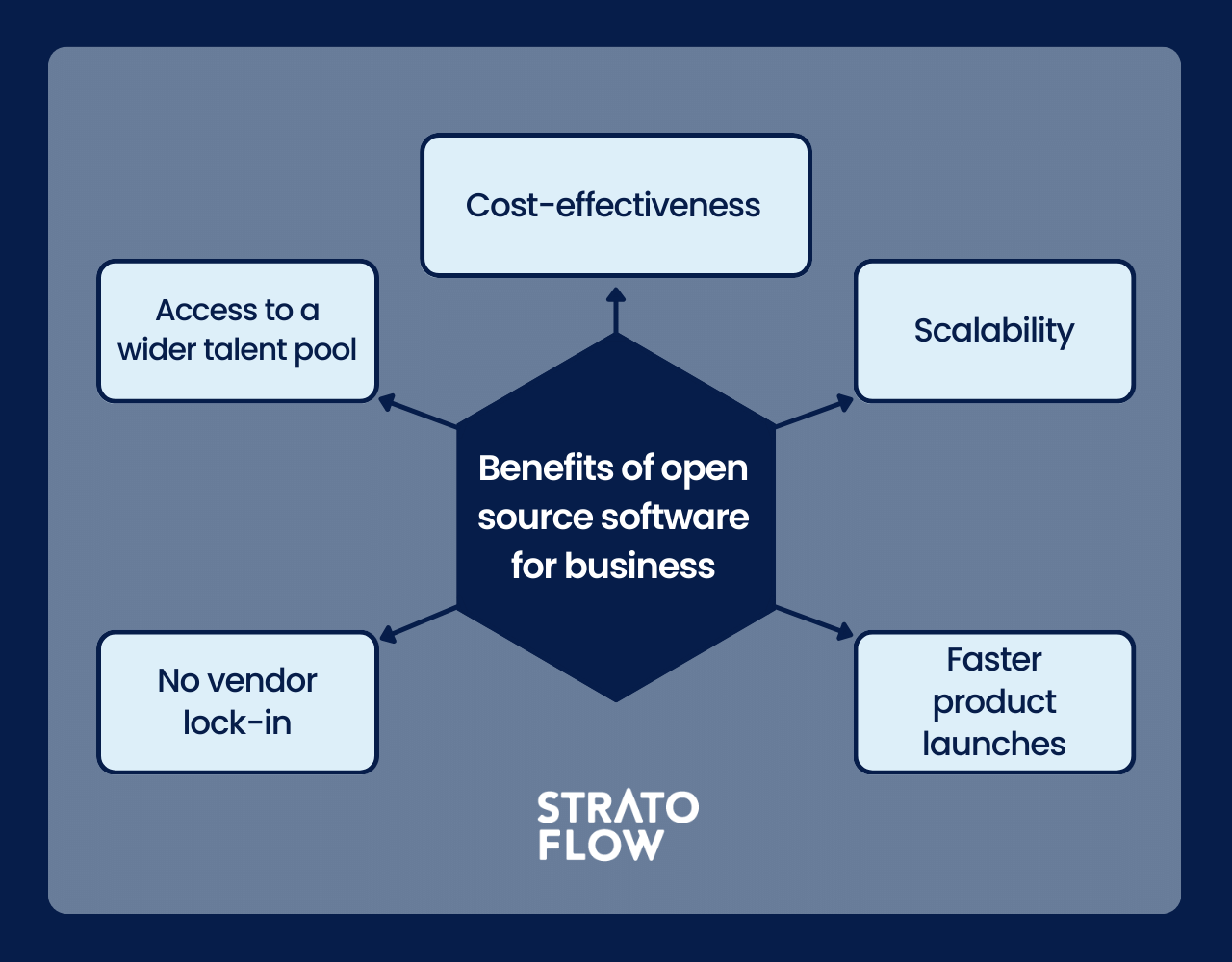
Cost-effectiveness
The primary benefit associated with open-source software is cost reduction.
In general, open-source software means that there are no mandatory fees for its use. This eliminates the administrative overhead of license renewals and minimizes maintenance fees for the entire software system.
For businesses, open-source solutions are often the most cost-effective option. This aspect is invaluable as it allows them to allocate their software budget elsewhere, optimizing their financial resources.
Scalability
One of the key benefits of open-source is the ability to start small and scale the project if there’s demand or if it meets the strategic goals of the organization.
For example, let’s consider an open-source low-code platform. Development teams can start with the solution completely free, but as business needs arise, they can leverage commercially supported versions to meet their growing needs. This open-source advantage makes it easier for companies to try different solutions and scale them as needed.
Faster product launches
Incorporating open-source solutions into your tech stack can accelerate software product deployments by leveraging several key advantages. First, open-source software often comes with proven and reliable components, reducing the need to build everything from scratch. This speeds up development cycles.
In addition, the active developer communities behind open-source projects regularly release updates, enhancements, and security patches, allowing teams to stay current without extensive internal development efforts.
Overall, open-source solutions streamline development processes, promoting faster and more efficient delivery of software products.

No vendor lock-in
How can we talk about the benefits of open-source software without mentioning the lack of vendor lock-in?
Vendor lock-in refers to a situation where a customer becomes heavily dependent on a particular vendor’s products or services, making it difficult or costly to switch to alternative solutions. Open-source software is flexible in that developers can see how the code works and make changes to it. This allows them to customize the software to meet their or their organization’s needs. There are no proprietary APIs and connectors, so development teams can move their solutions to another vendor at any time.
Flexibility is one of the biggest advantages of open-source software, as the freedom from vendor lock-in and the ability to change, rebuild, and scale the application is incredibly important in the ever-evolving business environment.
Access to a wider talent pool
The more popular the tech stack, the easier it is to find talented developers.
It’s that simple.
Many open-source frameworks and solutions like Spring, MySQL, Angular, React, and Git are standard skills among senior developers. So if you’re thinking about choosing these elements when assembling a tech stack for your next software development project, you’ll have no problem finding skilled programmers familiar with these open-source technologies.

Disadvantages of open-source software
After exploring all the benefits and advantages of open-source software, it’s important to balance our understanding by examining its drawbacks. By considering both the pros and cons of open-source software, we can make informed decisions that reflect the complexities of using technology.
Lack of official support
Open-source tools often do not include dedicated customer support from the vendor, as opposed to custom development. Users typically rely on community forums, documentation, and peer support.
Potential security risks
Because the source code of open-source software is publicly available, it can be easier for cybercriminals to find and exploit vulnerabilities. This transparency can lead to increased security risks if not actively managed by maintaining security patches and performing code reviews. Although it is important to note that some open-source products pay a lot of attention to the security of their software, such as Openkoda, which uses continuous OWASP security scans, making it a safe bet.
Compatibility and integration challenges
Open-source projects are developed by diverse communities, which can result in different standards, frameworks, and technologies. This diversity can lead to compatibility and integration issues when combining multiple open-source tools within a project, requiring additional effort for effective integration.
Choose open-source software development
By now we can clearly see that open-source is a solid choice when it comes to choosing a tech stack for custom software development projects.
It provides great security, flexibility, cloud scalability, and excellent performance – all the necessary ingredients for successful application development.
But what I tell you that we can push this concept even further?
Enter low code open-source platforms like Openkoda – powerful development frameworks enabling programmers to build scalable, extensible, and secure SaaS and applications more efficiently. Openkoda can be a comprehensive low-code tool for enterprise software development that offers ready-made components for:
- Authentication and user management,
- Integrations with payment systems and message platforms,
- Application security with a complete audit trail,
- Dashboard with standard screens and forms,
- Multi-tenant deployment.
[Read more: Open Source Time Tracking Software: The Expert’s Guide]
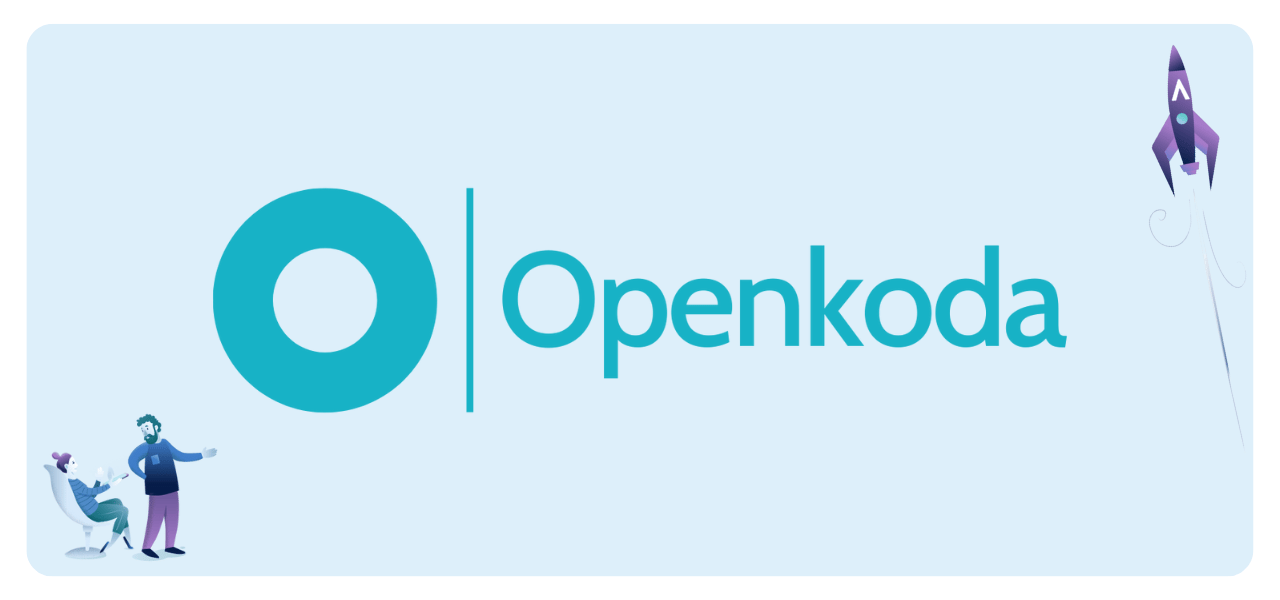
What is the biggest drawback of existing low-code solutions?
Without a doubt, it’s vendor lock-in.
Many organizations have shied away from low-code solutions for fear that their application could be locked into a proprietary vendor’s ecosystem forever and that getting it out would be a costly endeavor.
With open-source solutions, this risk can be avoided altogether. With Openkoda, you can get your applications to market faster while retaining full ownership of your code, virtually eliminating that pesky vendor lock-in.
[Read also: 16 Best Time Tracking Software Applications in 2023]
Conclusion
Open-source has become an integral part of the modern tech ecosystem, providing developers with a fertile ground for growth, managers with cost-effective solutions, and businesses with the agility to thrive in an ever-evolving digital landscape.
Its impact extends far beyond code, embodying a philosophy of transparency, collaboration, and innovation that continues to shape the future of software development and business success.
Related Posts
- How to Build an Inventory Management System: Key Steps and Tips
- How to Build a Document Management System: Alternative Approach
- Online Shopping Recommendations – Introducing Them to Your Business
- Amazon Product Recommendation System: How Does Amazon Algorithm Work?
- Movie Recommendation Systems: A Business Guide
Thank you for taking the time to read our blog post!